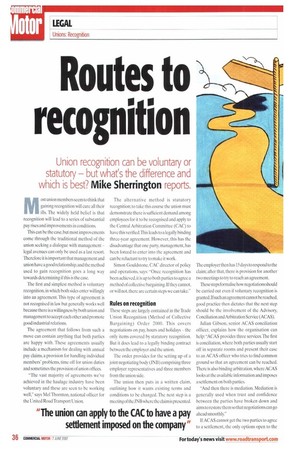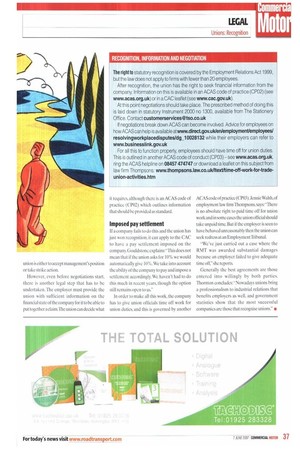Routes to recognition
Page 36

Page 37

If you've noticed an error in this article please click here to report it so we can fix it.
Union recognition can be voluntary or
statutory — but what's the difference and
which is best? Mike Sherrington reports.
Most union members seem to think that gaining recognition will cure all their ills. The widely held belief is that recognition will lead to a series of substantial pay rises and improvements in conditions.
This can be the case, but most improvements come through the traditional method of the union seeking a dialogue with management legal avenues can only he used as a last resort. Therefore it is important that management and union have a good relationship,and the method used to gain recognition goes a long way towards determining if this is the case.
The first and simplest method is voluntary recognition, in which both sides enter willingly into an agreement. This type of agreement is not recognised in law but generally works well because there is a willingness by both union and management to accept each other and promote (mod industrial relations.
The agreement that follows from such a move can contain anything that both parties are happy with. These agreements usually include a mechanism for dealing with annual pay claims, a provision for handling individual members' problems, time off for union duties and sometimes the provision of union offices.
"The vast majority of agreements we've achieved in the haulage industry have been voluntary and these are seen to be working well," says Mel Thornton, national officer for the United Road Transport Union. The alternative method is statutory recognition:to take this course the union must demonstrate there is sufficient demand among employees for it to be recognised and apply to the Central Arbitration Committee (CAC) to have this verified.This leads to a legally binding three-year agreement. However, this has the disadvantage that one party. management, has been forced to enter into the agreement and can be reluctant to try to make it work.
Simon Gouldstone, CAC director of policy and operations, says: "Once recognition has been achieved, it is up to both parties to agree a method of collective bargaining. If they cannot, or will not. there are certain steps we can take."
Rules on recognition
These steps are largely contained in the Trade Union Recognition (Method of Collective Bargaining) Order 2000. This covers negotiations on pay, hours and holidays the only items covered by statutory recognition. But it does lead to a legally binding contract between the employer and the union.
The order provides for the setting up of a joint negotiating body (JNB) comprising three employer representatives and three members from the union side.
The union then puts in a written claim, outlining how it wants existing terms and conditions to be changed. The next step is a meeting of the JNB where the claim ispresented. The employer then has 15 days to respond to the claim; after that, there is provision for another two meetings to try to reach an agreement.
These steps formalise how negotiations should be carried out even if voluntary recognition is granted.lf such an agreement cannot be reached, good practice then dictates that the next step should he the involvement of the Advisory, Conciliation and Arbitration Service (ACAS).
Julian Gibson, senior ACAS conciliation officer. explains how the organisation can help: "ACAS provides three services. The first is conciliation, where both parties usually start off in separate rooms and present their case to an ACAS officer who tries to find common ground so that an agreement can be reached. There is also binding arbitration, where ACAS looks at the available information and imposes a settlement on both parties.
-And then there is mediation. Mediation is generally used when trust and confidence between the parties have broken down and aims to restore them so that negotiations can go ahead smoothly."
If ACAS cannot get the two parties to agree to a settlement, the only options open to the union i s either to accept management's position or take strike action.
However, even before negotiations start, there is another legal step that has to be undertaken. The employer must provide the union with sufficient information on the financial state of the company for it to be able to put together a claim.The union can decide what it requires, although there is an ACAS code of practice (CP02) which outlines information that should be provided as standard.
Imposed pay settlement
if a company fails to do this and the union has just won recognition, it can apply to the CAC to have a pay settlement imposed on the company. Gouldstone explains: "This does not mean that if the union asks for 10% we would automatically give 10%. We take into account the ability of the company to pay and impose a settlement accordingly. We haven't had to do this much in recent years, though the option still remains open to us."
in order to make all this work, the company has to give union officials time off work for union duties, and this is governed by another ACAS code of practice (CP03). Jennie Walsh,of employment law firm "Ihompsons, says: "There is no absolute right to paid time off for union work and in some cases the union official should take unpaid Lime. But if the employer is seen to have behaved unreasonably then the union can seek redress at an Employment Tribunal.
'We've just carried out a case where the RMT was awarded substantial damages because an employer failed to give adequate time off:' she reports.
Generally the best agreements are those entered into willingly by both parties. Thornton concludes: "Nowadays unions bring a professionalism to industrial relations that benefits employers as well, and government statistics show that the most successful companies are those that recognise unions." •






















































































































































































